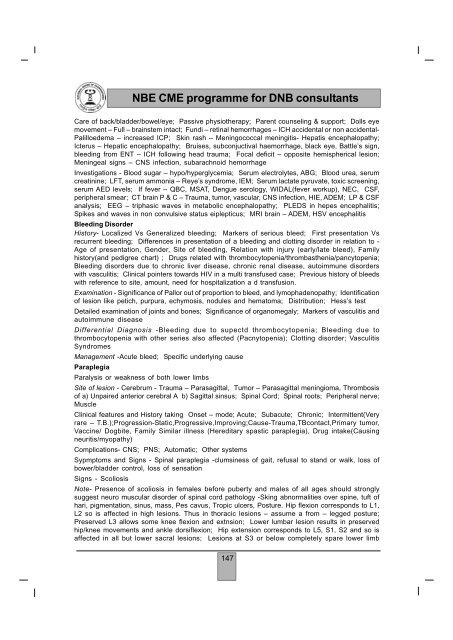NBE CME programme for DNB consultants - National Board Of ...
NBE CME programme for DNB consultants - National Board Of ...
NBE CME programme for DNB consultants - National Board Of ...
Create successful ePaper yourself
Turn your PDF publications into a flip-book with our unique Google optimized e-Paper software.
<strong>NBE</strong> <strong>CME</strong> <strong>programme</strong> <strong>for</strong> <strong>DNB</strong> <strong>consultants</strong>Care of back/bladder/bowel/eye; Passive physiotherapy; Parent counseling & support; Dolls eyemovement – Full – brainstem intact; Fundi – retinal hemorrhages – ICH accidental or non accidental-Palilloedema – increased ICP; Skin rash – Meningococcal meningitis- Hepatis encephalopathy;Icterus – Hepatic encephalopathy; Bruises, subconjuctival haemorrhage, black eye, Battle’s sign,bleeding from ENT – ICH following head trauma; Focal deficit – opposite hemispherical lesion;Meningeal signs – CNS infection, subarachnoid hemorrhageInvestigations - Blood sugar – hypo/hyperglycemia; Serum electrolytes, ABG; Blood urea, serumcreatinine; LFT, serum ammonia – Reye’s syndrome, IEM; Serum lactate pyruvate, toxic screening,serum AED levels; If fever – QBC, MSAT, Dengue serology, WIDAL(fever workup), NEC, CSF,peripheral smear; CT brain P & C – Trauma, tumor, vascular, CNS infection, HIE, ADEM; LP & CSFanalysis; EEG – triphasic waves in metabolic encephalopathy; PLEDS in hepes encephalitis;Spikes and waves in non convulsive status eiplepticus; MRI brain – ADEM, HSV encephalitisBleeding DisorderHistory- Localized Vs Generalized bleeding; Markers of serious bleed; First presentation Vsrecurrent bleeding; Differences in presentation of a bleeding and clotting disorder in relation to -Age of presentation, Gender, Site of bleeding, Relation with injury (early/late bleed), Familyhistory(and pedigree chart) ; Drugs related with thrombocytopenia/thrombasthenia/pancytopenia;Bleeding disorders due to chronic liver disease, chronic renal disease, autoimmune disorderswith vasculitis; Clinical pointers towards HIV in a multi transfused case; Previous history of bleedswith reference to site, amount, need <strong>for</strong> hospitalization a d transfusion.Examination - Significance of Pallor out of proportion to bleed, and lymophadenopathy; Identificationof lesion like petich, purpura, echymosis, nodules and hematoma; Distribution; Hess’s testDetailed examination of joints and bones; Significance of organomegaly; Markers of vasculitis andautoimmune diseaseDifferential Diagnosis -Bleeding due to supectd thrombocytopenia; Bleeding due tothrombocytopenia with other series also affected (Pacnytopenia); Clotting disorder; VasculitisSyndromesManagement -Acute bleed; Specific underlying causeParaplegiaParalysis or weakness of both lower limbsSite of lesion - Cerebrum - Trauma – Parasagittal, Tumor – Parasagittal meningioma, Thrombosisof a) Unpaired anterior cerebral A b) Sagittal sinsus; Spinal Cord; Spinal roots; Peripheral nerve;MuscleClinical features and History taking Onset – mode; Acute; Subacute; Chronic; Intermittent(Veryrare – T.B.);Progression-Static,Progressive,Improving;Cause-Trauma,TBcontact,Primary tumor,Vaccine/ Dogbite, Family Similar illness (Hereditary spastic paraplegia), Drug intake(Causingneuritis/myopathy)Complications- CNS; PNS; Automatic; Other systemsSypmptoms and Signs - Spinal paraplegia -clumsiness of gait, refusal to stand or walk, loss ofbower/bladder control, loss of sensationSigns - ScoliosisNote- Presence of scoliosis in females be<strong>for</strong>e puberty and males of all ages should stronglysuggest neuro muscular disorder of spinal cord pathology -Sking abnormalities over spine, tuft ofhari, pigmentation, sinus, mass, Pes cavus, Tropic ulcers, Posture. Hip flexion corresponds to L1,L2 so is affected in high lesions. Thus in thoracic lesions – assume a from – legged posture;Preserved L3 allows some knee flexion and extnsion; Lower lumbar lesion results in preservedhip/knee movements and ankle dorsiflexion; Hip extension corresponds to L5, S1, S2 and so isaffected in all but lower sacral lesions; Lesions at S3 or below completely spare lower limb147
















